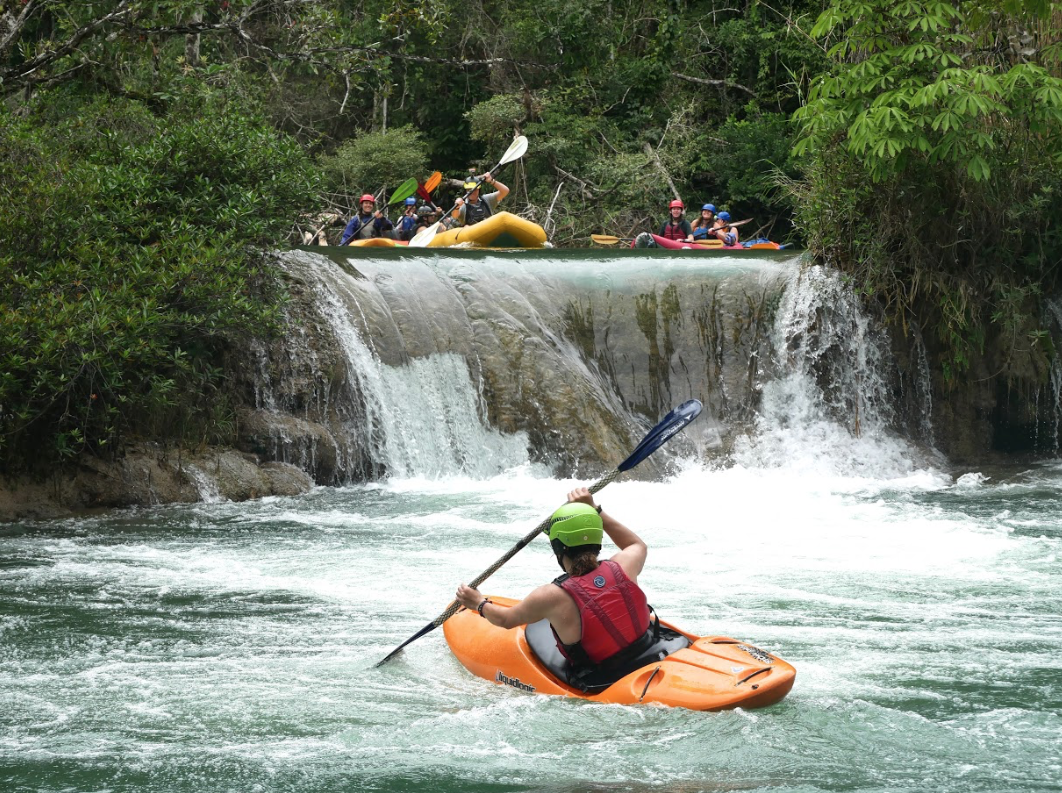Coconuts, Machetes and a Beautiful River Make For a Memorable Pacific Outdoor Pursuit

My younger sister often asks me, “What is different between taking students on an ‘international’ expedition than taking students on expeditions in the US?”. Considering that she has lived in Burkina Faso, China, and India for the past 8 years, I think it’s a fair question, and a question I grapple with regularly. I recently led a group of students on an expedition down the Río Lacanjá in eastern Chiapas, Mexico. During this trip, the answer to my sister’s question was illuminated. The cultural interactions among all participants on this international trip were stronger than any I have ever encountered in another venue.
On Jan. 11, we began setting up our inflatable rafts and kayaks for an 8-day, 120-km river through the heart of the Montes Azules rainforest. The party consisted of the 18 of us and a local support crew essential to help us launch and take-out. I’m not certain, but I would guess 18 is the largest group to ever ply the waters of the Lacanjá.
Along with the 12 students from Pacific University, the team included six guides with various skills and competencies. Alejandro Quiroga, who I first met on the Lacanjá seven years ago, is a Monterrey-born guide who now lives in San Cristobal Las Casas. He spends much of his guiding time taking tourists to ruins throughout Chiapas and the Yucatán region and has become an expert on Mayan history. Sunción Lopez brings an intimate knowledge of the forest and natural history. He grew up in Frontera Corozal along the banks of the Río Usumacinta where the pristine Lacanjá eventually pours into. Sunción is a fine rafter and he knows the interactions of nearly every tree, animal, and insect with humans. Alejandro Chankin (Alex), joined us at the put-in which is near his home. Alex is Lacandon and his people occupy the isolated region in and around the Lacanjá. It is estimated there are only 650 people speaking Lacandon today, of which Alex is a fluent speaker. We would not even attempt to travel this river without him. Amaranta Uribe is a sea kayak guide I knew from Baja California Sur. Her medical, translation, and interpersonal skills would prove to be critical throughout the trip. Rounding out the team was myself and raft-guide partner, Ashley Borman.
I have had the good fortune to lead several large expeditions in Mexico, including a Pacific University trip down the Río Usumacinta in January 2018 and a 540-km trip down the Río Grande de Santiago in Jalisco/Nayarit for a documentary in 2015. The varied team of guides offered close connections of shared interests and values that generated a unique facet of adventure tourism. We are all “crazy about the river,” as my friend Amaranta pointed out. This basic shared passion more than 10 days of intimate contact time fostered deep connections among the guides and new friends. I have always had more difficulty building these quality relationships outside of the guiding and adventure tourism worlds (e.g. mass tourism).
The students also begin to feel these bonds growing as each night we inspect our wounds and pull thorns from each others feet while discussing our varying levels of gastro-intestinal illness over dinner. As the flames crackle, there is no other entertainment each night besides each other. The social norms, social media, and social stigma we all face in the modern world are thrown away in exchange for views of authentic personalities and breaking points. Group members may find themselves tired, angry, frustrated, and sometimes crying at the end of an exhausting day. But at the same time, the next day, they feel better about themselves knowing we supported each other, even at our most vulnerable moments. This is true expedition behavior.
Of course, we learn a great deal about each others lives as well. By the end of the expedition we will all know a version of each others life history, likes and dislikes. We will also learn a good amount of Spanish or English. It is in these contexts that learning about each other is much deeper than a normal transactional encounter allows while traveling, and the shared cultural exchange deepens connections by all.
This trip would also hold a unique surprise for us at its terminus. Our expedition had been marked by all the typical hardships expected in the jungle: macheteing through brushy passages, legs covered in hundreds of bug bites, and spider monkeys hurling feces at us as we tried to pitch camp. We were over a day late arriving to our destination on the Río Lacantún where we would exit the jungle and take-out.
Our surprise was an unplanned night in the tiny town of Quiringuicharo (pop. 1,000) at the generosity to he Paz family. With little notice, Isabelle Dominguez Paz assembled a feast and all 18 of us sat down for our final meal in her dining room. Their hospitality and warmth helped lift all our spirits as we pitched our tents in their front lawn across the dirt street from the soccer field. In the morning fog, one of Isabelle’s sons climbed a palm tree to collect 18 coconuts, one for each of us. As we sipped the sweet water from the coconuts students exchanged words and thanks to the family that had taken us in for the night. No amount of meticulous planning could have made for a more perfect ending to such an adventure. The power of connection and understanding amongst everyone there was so palpable you could almost reach out and snatch it from the air.
Students interested in joining a trip like this can sign up for OL-310 International Expedition during alternating winter terms. OL-103 Intro to Expedition Planning is the required prerequisite course. You can learn more at the Outdoors Pursuits site.


